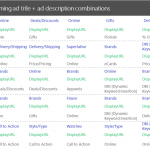The $21.eight-Billion motive ultra-non-public online advertisements Are Coming
Globally, $21.8 billion value of ads gained’t make it to eyeballs this yr as a result of advert blockading. A conceivable savior: hypertargeted ads.
November 2, 2015
fast: When’s the final time you seen an advert on a website?
this query may not even follow to you, as a result of you have already got a software like Adblock Plus that wipes them all away. but should you do see advertisements, most likely you barely discover them now as a result of they are pathetically inappropriate, like that one for a product you just offered.
“Frankly, our industry lately has taken the straightforward step, which is showing ads to people who have simply long past to that website online or simply viewed that product,” says Jag Duggal, head of product for online audience dimension and realtime ad placement company Quantcast.
If simplest on-line advertisements had been more centered, Duggal says, everyone would be happy. “We consider that if we will show extra related commercials, it’ll be more helpful for customers. they’re going to be less inclined to dam them, we can have to indicate fewer ads, advertisers will be keen to spend extra for every advert. And the income for publishers and information suppliers like us will go up.”
Duggal’s every person-wins worldview isn’t a surprise: That’s the promise Quantcast and companies find it irresistible are promoting to advertisers and content web sites corresponding to BuzzFeed and The Wall boulevard Journal. Quantcast has simply boosted the promise by introducing a brand new system called audience Grid. This open platform can absorb more knowledge from many more information sources than sooner than.
target market Grid is now pulling in information on what folks purchase, what they pressure, what they watch, and extra. It brings in 14 new information firms equivalent to TiVo research (for purchaser viewing habits), Kantar Shopcom (a purchase order database of greater than 231 million U.S. consumers), Relevate (info on the automobiles that thousands and thousands of people drive), and PlaceIQ (which tracks people’s mobile-instrument movements with accuracy right down to squares of 100 x one hundred meters). Quantcast plans to maintain pursuing more sources. (It had already been tracking normal passion, demographic knowledge, and political pursuits ahead of launching target audience Grid.)
The staring at recreation
If the hairs on the again of your neck just stood up, you’re not by myself. A March 2014 survey of 1,000 americans by way of market analysis firm GfK (which later become a part of target audience Grid) suggested that “virtually 80% of respondents feel that there should be extra laws preventing firms from repurposing personal knowledge to third parties.” those “third events” embody advertisers. this attitude doesn’t alternate while you eliminate the older consumers. A full eighty% of millennials felt that method (versus 73% of gen-Xers). just 25% of all respondents (and 33% of millennials) said they principally or totally belief how entrepreneurs and advertisers deal with their personal data.
these entrepreneurs and advertisers would counter that this information isn’t in reality personal, or at least, now not “in my view identifiable,” because the term of art describes it. Quantcast knows that someone with particular procuring and tv pursuits also happens to be on a selected webpage or cellular app screen for participating media companies together with BuzzFeed, Demand Media, The Economist, Federated Media, Gawker Media, NBC universal, OpenTable, The Telegraph, Vox Media, Yelp, or The Wall street Journal—all of which use Quantcast’s dimension and ad-placement technology. That helps it serve an advert focused to as a minimum a few of these interests. (notice: quick company, its sister web site Inc., and mother or father firm Mansueto Ventures usually are not Quantcast shoppers.)
in line with Quantcast, there are no laws that specifically restrict it or opponents reminiscent of Alexa, Compete, comScore, Criteo, Localytics, and RocketFuel from gathering individually identifiable information (PII). however it’s actually more straightforward, the company says, to use most effective anonymous data, as that saves the headache of navigating a number of regulations that do control use of personal info, such because the U.S. children’s online privacy protection Act and the California on-line privateness safety Act.
Quantcast additionally continues that retaining anonymity is considered one of its firm values. “We’ve deliberately built our complete information-administration and modeling approach to now not use PII,” says Quantcast’s CEO and cofounder, Konrad Feldman. as a substitute, Quantcast hires services such as LiveRamp, Datalogix, Drawbridge, or Tapad, which specialise in “de‑identification” of shopper information, stripping names, e-mail addresses, or different private info out of its marketing data prior to sending it to Quantcast.
here’s an example of how the anonymizing process works: TiVo knows what you watch and has the e-mail address you used to register for the provider. different companies, corresponding to Evite, may also have your email if any person has sent you an invite—and since it’s a must to discuss with Evite’s website online to RSVP, it can add a cookie (a small textual content file) to a cache on your net browser. Quantcast also drops cookies, which hyperlinks them to viewing preferences on web sites of shoppers like The Wall side road Journal.
Now along comes LiveRamp. It hyperlinks the TiVo information and Evite cookie using the e-mail address. LiveRamp additionally hyperlinks Evite and Quantcast in the case of net browsers that hold cookies from each corporations. So now Quantcast is aware of what you watched on TiVo and what you learn on the Journal‘s website, but LiveRamp has stripped out the identify and any other data that may be traced back to a selected human.
From that, Quantcast cannot only tell advertisers that individuals who read the Journal also watch, say, the great spouse, it will possibly additionally situation advertisements for shows just like the nice wife on WSJ web pages that just right spouse enthusiasts learn. The WSJ will get moneymaking ads, and readers would possibly get ideas for a exhibit they in truth wish to watch. every other instance from Quantcast’s research: individuals who discuss with each ThinkProgress.org and Eater.com have a tendency to love the convey Sleepy hole on Fox.
“We don’t comprehend who you’re,” says Feldman. “We most effective have basically a random number that we’re able to synchronize in the future with our different random number.”
In different words, Quantcast is associating the random selection of the eVite cookie, which is now linked with TiVo viewership, from the above instance to the random selection of the Quantcast cookie, which is attached to readership on a “Quantified,” or Quantcast-enabled web site.
All of this assumes somebody is even seeing the advert. As of the second quarter of this year, sixteen% of on-line americans, about 45 million people, had installed advert-blocking off instrument, in keeping with an August 2015 report by means of PageFair, a company that helps web pages use advertisements that blockers will permit thru. That’s a doubling from the yr earlier than. meanwhile, 77 million Europeans are blocking ads. Globally, $21.eight billion value of advertisements won’t make it to eyeballs this yr.
Quantcast’s vision additionally requires that you just dangle onto cookies long sufficient for it, LiveRamp, and others to work their below-the-hood magic. “lots of these identifiers [including cookies] are deleted on occasion, and even continuously,” says Feldman. net browsers tend to simply accept cookies by using default, but supply options to block and delete them, especially the “0.33-party” cookies that don’t can help you use a site better (such as automatically logging you in) but which might be positioned by marketers and advert companies such as Quantcast.
tracking in your Pocket
the standard version of internet advertising is ads in computer web browsers. however readership is shifting to cell quick and now debts for 38% of all web browsing, according to that PageFair report. BuzzFeed’s cell site visitors had already outstripped its computer-based totally readership again in 2013, consistent with Quantcast.
The switch to mobile is somewhat excellent for advertisers. Like their pc variations, cellular browsers additionally allow folks to dam or delete cookies, but cellular apps don’t rely best on easily flushed browser cookies. instead, advertisers get admission to device identifiers, referred to as IDFA for iOS and AAID for Android. “Identifiers within the cellular space are typically harder,” says Duggal. (Quantcast can be expanding into sensible TVs, offering instrument identifier functionality to Roku’s ad-supported apps.)
internet marketing’s nemesis is chasing it onto phones and capsules. PageFair’s study found that just one.6% of ad blocking off was taking place on cellular gadgets, however that was once sooner than Apple launched iOS 9, which for the primary time allows advert blockers on Apple’s cell devices. one in all them, Been option, even blocks advertisements within apps. (Apple has intermittently banned Been choice from the App retailer due, it says, to issues about it collecting person information.)
in short, there is not any escaping advert blockers, so if publishers and advertisers can’t beat them, perhaps they may be able to sign up for them. Adblock Plus’s guardian company, Eyeo, has developed desirable ad pointers for advertisements that it’s going to enable thru its blocker. These ads have to be “whitelisted” with Adblock Plus as acceptable prior to running. the rules include requiring that advertisements aren’t animated and don’t appear as pop-united statesthat cover the webpage. (customers can nonetheless elect to dam all ads.) Given the dominant function of Adblock Plus available in the market (with more than 300 million downloads), it has the facility to decide if and in what type internet advertising survives.
The promise by way of Quantcast and others to come up with more relevant ads which can be extra treasured to advertisers and users seems to jibe with Eyeo’s mission. Eyeo states on its house web page that the corporate has ” . . . learned that almost all customers wouldn’t mind seeing higher, more informative advertisements.”
That appears to contradict what internet surfers have said in surveys, but Duggal thinks the vital issue is solely how focused these ads are. “Taken too a long way, it is creepy,” he says. “You don’t do merchandising for delicate classes or sensitive issues that’s hyper-related.”
people received’t get wigged out by way of an advert for a new soda, he says, and even for merchandise that focus on them by using age workforce. but Quantcast steers clear of many prescription drugs. Duggal then retains hinting about “the obvious one,” with out naming it, until I at last ask if he manner extremely centered ads for erectile dysfunction medication.
“That,” he says, “is both tense and creepy.”
quick company , learn Full Story
(15)













